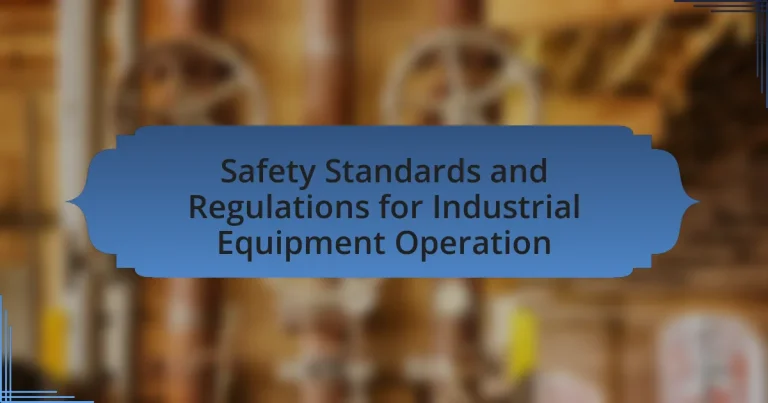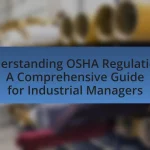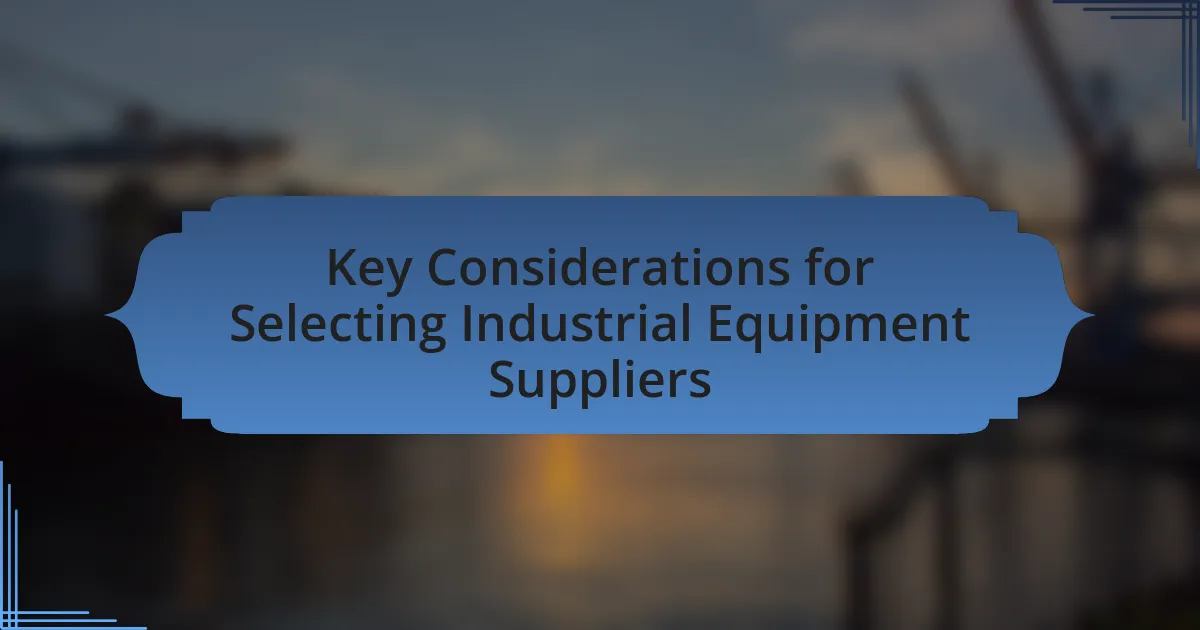Safety standards and regulations for industrial equipment operation are essential guidelines and legal requirements aimed at ensuring the safe use of machinery in industrial environments. Key organizations such as the Occupational Safety and Health Administration (OSHA) and the American National Standards Institute (ANSI) establish these standards to minimize risks of accidents and injuries, enhance operational efficiency, and protect workers. The article covers the importance of compliance with safety standards, the risks associated with inadequate safety measures, the roles of various regulatory bodies, and the specific safety requirements for operating industrial equipment. Additionally, it discusses the significance of training, personal protective equipment (PPE), and maintenance practices in maintaining safety standards, as well as strategies for continuous improvement and overcoming challenges in adherence to safety regulations.
What are Safety Standards and Regulations for Industrial Equipment Operation?
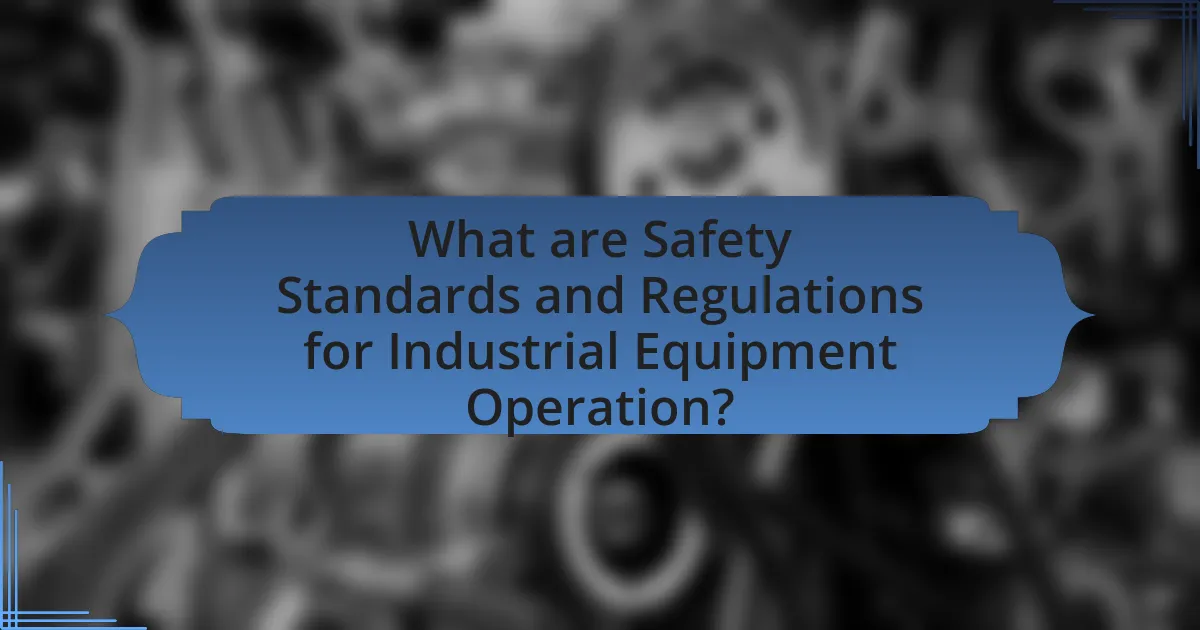
Safety standards and regulations for industrial equipment operation are guidelines and legal requirements designed to ensure the safe use of machinery and equipment in industrial settings. These standards, such as those established by the Occupational Safety and Health Administration (OSHA) in the United States, mandate specific safety practices, equipment maintenance protocols, and employee training to minimize risks of accidents and injuries. For instance, OSHA’s General Industry Standards (29 CFR 1910) outline requirements for machine guarding, personal protective equipment, and hazard communication, which are critical for maintaining a safe workplace. Compliance with these regulations not only protects workers but also helps organizations avoid legal penalties and enhance operational efficiency.
Why are Safety Standards and Regulations important in industrial settings?
Safety standards and regulations are crucial in industrial settings to protect workers, ensure safe operations, and minimize risks. These standards provide a framework for identifying hazards, implementing safety measures, and maintaining compliance with legal requirements. For instance, the Occupational Safety and Health Administration (OSHA) sets regulations that have significantly reduced workplace injuries and fatalities, with statistics showing a decline in injury rates by over 60% since its establishment in 1970. By adhering to these standards, industries can foster a safer work environment, enhance productivity, and reduce costs associated with accidents and legal liabilities.
What risks do inadequate safety standards pose to workers?
Inadequate safety standards pose significant risks to workers, including increased likelihood of accidents, injuries, and fatalities. For instance, according to the Occupational Safety and Health Administration (OSHA), workplaces with poor safety protocols experience higher rates of incidents such as falls, equipment malfunctions, and exposure to hazardous materials. These incidents can lead to severe physical harm, long-term health issues, and even death, underscoring the critical importance of adhering to established safety regulations.
How do safety standards protect equipment and facilities?
Safety standards protect equipment and facilities by establishing guidelines that ensure safe operation, maintenance, and design practices. These standards minimize risks of accidents, equipment failure, and environmental hazards, thereby extending the lifespan of machinery and infrastructure. For instance, the Occupational Safety and Health Administration (OSHA) sets regulations that require regular inspections and maintenance of equipment, which helps identify potential issues before they lead to costly breakdowns or accidents. Additionally, adherence to standards such as ISO 9001 promotes quality management systems that enhance operational efficiency and safety, further safeguarding both equipment and facilities.
What are the key organizations involved in establishing these standards?
The key organizations involved in establishing safety standards and regulations for industrial equipment operation include the American National Standards Institute (ANSI), the Occupational Safety and Health Administration (OSHA), and the International Organization for Standardization (ISO). ANSI coordinates the development of voluntary consensus standards for various industries in the United States, ensuring that safety protocols are met. OSHA, a part of the U.S. Department of Labor, sets and enforces workplace safety standards to protect workers from hazards. ISO develops international standards that ensure quality, safety, and efficiency across different sectors, including industrial equipment. These organizations collectively contribute to the framework that governs safety practices in industrial environments.
What roles do OSHA and ANSI play in safety regulations?
OSHA (Occupational Safety and Health Administration) and ANSI (American National Standards Institute) play crucial roles in safety regulations by establishing and enforcing standards that protect worker health and safety. OSHA is a federal agency responsible for ensuring safe and healthful working conditions by setting and enforcing standards, providing training, and conducting inspections. For example, OSHA’s regulations cover a wide range of workplace hazards, including exposure to toxic substances and machinery safety.
ANSI, on the other hand, develops consensus standards that provide guidelines for safety practices and equipment design. These standards are often referenced by OSHA in its regulations, ensuring that industry practices align with recognized safety benchmarks. For instance, ANSI standards for personal protective equipment (PPE) help ensure that such equipment meets minimum safety requirements, thereby reducing workplace injuries.
Together, OSHA and ANSI create a framework that not only mandates compliance but also promotes continuous improvement in workplace safety through the adoption of best practices and standards.
How do international standards like ISO influence local regulations?
International standards like ISO significantly influence local regulations by providing a framework that enhances safety, quality, and efficiency in industrial operations. These standards serve as benchmarks that local regulatory bodies can adopt or adapt to ensure compliance with global best practices. For instance, ISO 9001, which focuses on quality management systems, encourages local regulations to incorporate similar principles, thereby improving product quality and customer satisfaction. Additionally, ISO standards often facilitate international trade by harmonizing requirements, which local regulations may reflect to attract foreign investment and ensure competitiveness. This alignment with ISO standards can lead to improved safety outcomes, as seen in industries like manufacturing and construction, where adherence to ISO safety standards has been linked to reduced accident rates and enhanced operational performance.
What are the main types of safety standards applicable to industrial equipment?
The main types of safety standards applicable to industrial equipment include ISO standards, ANSI standards, and OSHA regulations. ISO standards, such as ISO 12100, provide guidelines for risk assessment and risk reduction in machinery. ANSI standards, particularly ANSI B11, focus on the safety of machinery and the responsibilities of manufacturers and users. OSHA regulations establish mandatory safety and health standards for workplaces, ensuring that industrial equipment meets specific safety criteria to protect workers. These standards collectively aim to minimize risks and enhance safety in industrial environments.
What are the differences between general safety standards and equipment-specific standards?
General safety standards provide broad guidelines applicable across various industries, while equipment-specific standards focus on the safety requirements tailored to particular types of equipment. General safety standards, such as those established by organizations like OSHA, aim to ensure a baseline level of safety for all workers, addressing issues like hazard communication and personal protective equipment. In contrast, equipment-specific standards, such as those from ANSI or ISO, detail the safety protocols and operational procedures necessary for the safe use of specific machinery, like forklifts or industrial robots. This distinction is crucial as it allows for a comprehensive safety framework that addresses both overarching safety principles and the unique risks associated with particular equipment.
How do performance standards differ from design standards?
Performance standards focus on the operational effectiveness and outcomes of equipment, while design standards emphasize the specifications and criteria for the construction and configuration of that equipment. Performance standards are often measured through metrics such as efficiency, reliability, and safety during actual use, ensuring that the equipment meets specific operational goals. In contrast, design standards provide guidelines for the materials, dimensions, and processes used in creating the equipment, ensuring that it is built to certain safety and quality benchmarks. For example, the American National Standards Institute (ANSI) sets performance standards that dictate how machinery should operate under various conditions, while the International Organization for Standardization (ISO) outlines design standards that specify how machinery should be constructed to ensure safety and functionality.
How are safety standards enforced in industrial environments?
Safety standards in industrial environments are enforced through a combination of regulatory compliance, training programs, and regular inspections. Regulatory bodies, such as the Occupational Safety and Health Administration (OSHA) in the United States, establish specific safety standards that industries must adhere to, ensuring a baseline level of safety. Compliance is monitored through scheduled inspections and audits, which assess adherence to these standards. Additionally, companies implement training programs for employees to educate them on safety protocols and proper equipment usage, further reinforcing the importance of safety in the workplace. Regular inspections and employee training are critical components that validate the enforcement of safety standards, as they help identify potential hazards and ensure that safety measures are actively practiced.
What are the consequences of non-compliance with safety regulations?
Non-compliance with safety regulations can lead to severe consequences, including legal penalties, financial losses, and increased risk of accidents. Organizations may face fines and sanctions imposed by regulatory bodies, which can amount to thousands or even millions of dollars depending on the severity of the violation. Additionally, non-compliance can result in costly lawsuits from injured parties or employees, further straining financial resources.
Moreover, the failure to adhere to safety standards can significantly elevate the likelihood of workplace accidents, leading to injuries or fatalities. According to the Occupational Safety and Health Administration (OSHA), businesses that do not comply with safety regulations are at a higher risk of incidents that can disrupt operations and damage equipment. This not only affects employee morale but can also tarnish a company’s reputation, leading to loss of clients and business opportunities.
What are the specific safety requirements for operating industrial equipment?
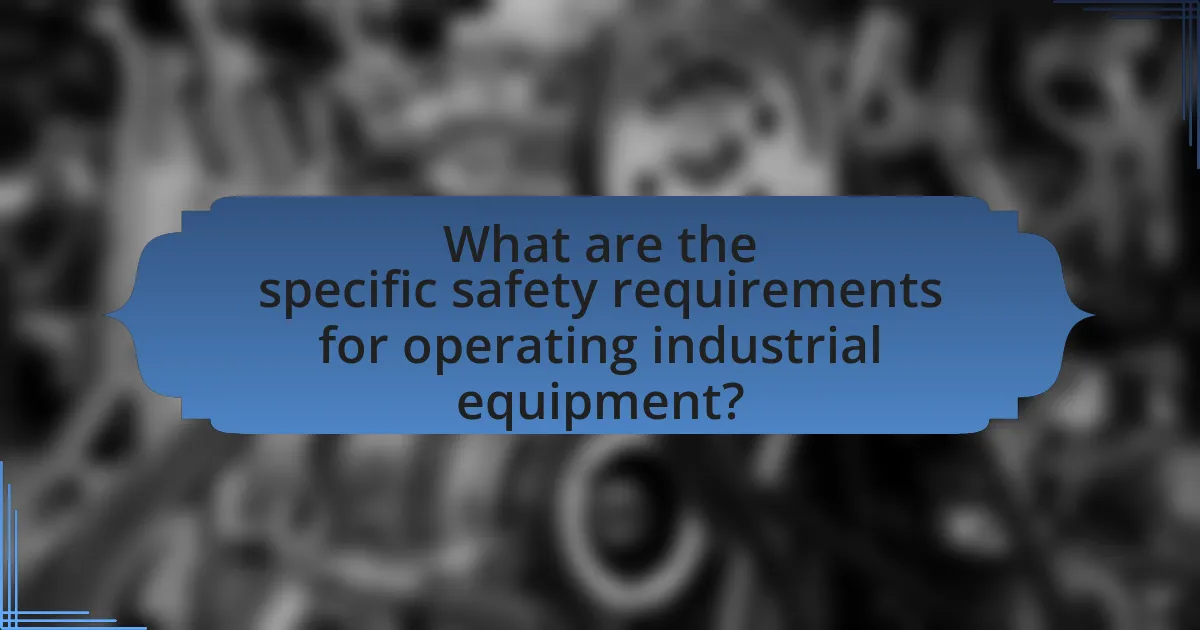
The specific safety requirements for operating industrial equipment include proper training, use of personal protective equipment (PPE), adherence to operational procedures, and regular maintenance checks. Proper training ensures that operators understand the equipment’s functions and safety protocols, reducing the risk of accidents. The use of PPE, such as helmets, gloves, and eye protection, safeguards workers from potential hazards. Adhering to established operational procedures minimizes errors during equipment operation, while regular maintenance checks help identify and rectify potential issues before they lead to failures or accidents. These requirements are supported by regulations such as OSHA standards, which mandate safety practices in industrial environments to protect workers’ health and safety.
What training is required for operators of industrial equipment?
Operators of industrial equipment are required to undergo specific training that includes safety protocols, equipment operation procedures, and emergency response techniques. This training is essential to ensure that operators can safely and effectively manage the equipment, minimizing risks to themselves and others. According to the Occupational Safety and Health Administration (OSHA), operators must complete training that covers the proper use of equipment, hazard recognition, and compliance with safety regulations. Additionally, many industries mandate certification programs that validate an operator’s competency in handling specific types of machinery, further reinforcing the importance of structured training in maintaining workplace safety.
How often should safety training be conducted?
Safety training should be conducted at least annually for all employees. This frequency aligns with guidelines from organizations such as the Occupational Safety and Health Administration (OSHA), which emphasizes the importance of regular training to ensure that workers are aware of safety protocols and can respond effectively to hazards. Additionally, specific industries may require more frequent training sessions based on the nature of the work and the risks involved, such as quarterly training for high-risk environments. Regular training helps maintain compliance with safety standards and reduces the likelihood of accidents and injuries in the workplace.
What topics should be covered in operator training programs?
Operator training programs should cover safety standards, equipment operation procedures, emergency response protocols, and maintenance practices. These topics ensure that operators are well-versed in the necessary regulations and best practices for safe and efficient equipment use. For instance, understanding OSHA regulations is crucial, as they provide guidelines that help prevent workplace accidents and injuries. Additionally, training on specific equipment operation procedures enhances proficiency and reduces the likelihood of operational errors. Emergency response training prepares operators to handle unexpected situations effectively, while knowledge of maintenance practices ensures equipment longevity and reliability.
What personal protective equipment (PPE) is necessary for safe operation?
Personal protective equipment (PPE) necessary for safe operation includes safety helmets, eye protection, hearing protection, gloves, respiratory protection, and safety footwear. These items are essential to protect workers from various hazards present in industrial environments. For instance, safety helmets safeguard against head injuries from falling objects, while eye protection prevents injuries from flying debris or chemical splashes. Hearing protection is crucial in environments with high noise levels to prevent hearing loss. Gloves protect hands from cuts, abrasions, and chemical exposure, and respiratory protection is vital in areas with airborne contaminants. Lastly, safety footwear provides protection against punctures and slips. Compliance with safety standards, such as those set by the Occupational Safety and Health Administration (OSHA), reinforces the importance of using appropriate PPE to minimize risks and ensure worker safety.
What types of PPE are commonly required for different equipment?
Personal Protective Equipment (PPE) commonly required for different equipment includes safety goggles for machinery operation, gloves for handling sharp tools, and hard hats for overhead protection. For example, when operating power tools, safety goggles protect against flying debris, while gloves provide grip and protect hands from cuts. Hard hats are essential in environments where there is a risk of falling objects, ensuring head safety. These requirements are outlined in safety regulations such as OSHA standards, which mandate specific PPE based on the hazards associated with various equipment.
How should PPE be maintained and inspected?
PPE should be maintained and inspected regularly to ensure its effectiveness and safety. Regular maintenance includes cleaning, repairing, and replacing damaged components, while inspections should occur before each use and periodically throughout the equipment’s lifespan. According to the Occupational Safety and Health Administration (OSHA), employers are required to ensure that PPE is in a safe and reliable condition, which includes following manufacturer guidelines for maintenance and inspection. This systematic approach helps prevent workplace injuries and ensures compliance with safety regulations.
What are the best practices for maintaining safety standards during equipment operation?
The best practices for maintaining safety standards during equipment operation include conducting regular safety training, performing routine equipment inspections, and adhering to established safety protocols. Regular safety training ensures that all operators are aware of potential hazards and the correct procedures to mitigate risks. Routine equipment inspections help identify wear and tear or malfunctions before they lead to accidents, as studies show that 70% of equipment failures can be prevented through proper maintenance. Adhering to established safety protocols, such as using personal protective equipment and following lockout/tagout procedures, significantly reduces the likelihood of workplace injuries.
How can regular inspections contribute to safety compliance?
Regular inspections significantly enhance safety compliance by identifying hazards and ensuring adherence to safety regulations. These inspections systematically evaluate equipment, processes, and work environments, allowing organizations to detect potential safety violations before they lead to accidents. For instance, a study by the Occupational Safety and Health Administration (OSHA) found that workplaces conducting regular safety inspections experienced a 30% reduction in workplace injuries. This evidence underscores the effectiveness of inspections in maintaining compliance with safety standards and fostering a culture of safety within organizations.
What role does equipment maintenance play in safety standards?
Equipment maintenance is crucial for upholding safety standards in industrial operations. Regular maintenance ensures that machinery operates correctly, reducing the risk of malfunctions that could lead to accidents or injuries. For instance, the Occupational Safety and Health Administration (OSHA) mandates that employers maintain equipment to prevent hazards, highlighting that poorly maintained equipment is a leading cause of workplace injuries. Furthermore, studies show that organizations with robust maintenance programs experience 30% fewer accidents, demonstrating a direct correlation between effective maintenance and enhanced safety compliance.
How can organizations ensure ongoing compliance with safety standards?

Organizations can ensure ongoing compliance with safety standards by implementing a robust safety management system that includes regular training, audits, and updates to safety protocols. A safety management system provides a structured approach to identifying hazards, assessing risks, and ensuring that safety measures are effectively communicated and enforced. Regular training sessions for employees help reinforce safety practices and keep staff informed about any changes in regulations or procedures.
Additionally, conducting periodic audits allows organizations to evaluate their compliance status and identify areas for improvement. According to the Occupational Safety and Health Administration (OSHA), organizations that conduct regular safety audits can reduce workplace incidents by up to 30%. Furthermore, staying updated with industry regulations and standards, such as those set by the American National Standards Institute (ANSI) or the International Organization for Standardization (ISO), ensures that organizations adapt to any changes in safety requirements.
What strategies can be implemented for continuous safety improvement?
To achieve continuous safety improvement, organizations can implement strategies such as regular safety audits, employee training programs, and the adoption of safety management systems. Regular safety audits help identify hazards and assess compliance with safety standards, leading to actionable insights for improvement. Employee training programs ensure that all personnel are aware of safety protocols and best practices, which can reduce the likelihood of accidents. The adoption of safety management systems, such as ISO 45001, provides a structured framework for managing occupational health and safety risks, promoting a culture of safety within the organization. These strategies are supported by data indicating that organizations with robust safety management practices experience fewer workplace incidents and improved overall safety performance.
How can safety audits help maintain compliance?
Safety audits help maintain compliance by systematically evaluating an organization’s adherence to safety standards and regulations. These audits identify potential hazards, assess risk management practices, and ensure that safety protocols are being followed. By regularly conducting safety audits, organizations can uncover non-compliance issues before they lead to accidents or legal penalties, thereby reinforcing a culture of safety and accountability. Furthermore, according to the Occupational Safety and Health Administration (OSHA), organizations that implement regular safety audits can reduce workplace injuries by up to 40%, demonstrating the effectiveness of audits in maintaining compliance with safety regulations.
What is the importance of employee feedback in safety practices?
Employee feedback is crucial in safety practices as it provides insights into potential hazards and the effectiveness of existing safety measures. Engaging employees in safety discussions fosters a culture of safety, leading to improved compliance with safety protocols. Research indicates that organizations with active employee feedback mechanisms experience a 30% reduction in workplace accidents, demonstrating the tangible benefits of incorporating employee perspectives into safety practices.
What resources are available for staying updated on safety regulations?
To stay updated on safety regulations, individuals and organizations can utilize several key resources. Government agencies such as the Occupational Safety and Health Administration (OSHA) provide comprehensive guidelines and updates on safety standards. Additionally, industry-specific organizations, like the National Fire Protection Association (NFPA) and the American National Standards Institute (ANSI), regularly publish updates and standards relevant to safety regulations. Online platforms, including regulatory databases and safety compliance websites, also offer real-time updates and resources for compliance. Furthermore, subscribing to industry newsletters and attending safety conferences can enhance awareness of the latest regulatory changes.
How can organizations access training and certification programs?
Organizations can access training and certification programs by enrolling in accredited institutions or online platforms that specialize in safety standards and regulations for industrial equipment operation. These programs are often offered by professional organizations, industry associations, or educational institutions that provide structured curricula aligned with regulatory requirements. For instance, the Occupational Safety and Health Administration (OSHA) provides resources and training programs that organizations can utilize to ensure compliance with safety standards. Additionally, many online platforms, such as Coursera or LinkedIn Learning, offer courses that lead to certification in relevant safety practices, making it easier for organizations to access necessary training.
What online resources provide updates on safety standards?
Online resources that provide updates on safety standards include the Occupational Safety and Health Administration (OSHA) website, the National Institute for Occupational Safety and Health (NIOSH), and the American National Standards Institute (ANSI). These organizations regularly publish updates, guidelines, and standards relevant to workplace safety. For instance, OSHA’s website features a comprehensive database of regulations and safety standards that are frequently updated to reflect current practices and legal requirements. NIOSH offers research and recommendations on occupational safety, while ANSI develops and publishes consensus standards that are widely recognized in various industries.
What are some common challenges in adhering to safety standards?
Common challenges in adhering to safety standards include lack of employee training, insufficient resources for compliance, and resistance to change within organizational culture. Employee training is crucial, as inadequate knowledge about safety protocols can lead to accidents; a study by the National Safety Council found that 70% of workplace injuries are due to insufficient training. Insufficient resources, such as funding and personnel, hinder the implementation of safety measures, making it difficult for organizations to meet regulatory requirements. Additionally, resistance to change can stem from established practices and fear of disruption, which can impede the adoption of new safety standards.
How can organizations overcome resistance to safety protocols?
Organizations can overcome resistance to safety protocols by fostering a culture of safety that emphasizes the importance of compliance and employee involvement. Engaging employees in the development and implementation of safety protocols increases their buy-in and reduces resistance. Research indicates that organizations with strong safety cultures experience 50% fewer accidents and injuries, demonstrating the effectiveness of this approach. Additionally, providing ongoing training and clear communication about the benefits of safety protocols can help alleviate concerns and misconceptions, further encouraging adherence.
What are the implications of budget constraints on safety compliance?
Budget constraints significantly hinder safety compliance by limiting the resources available for necessary safety measures and training. When organizations face financial limitations, they often prioritize cost-cutting over safety investments, leading to inadequate safety protocols and insufficient employee training. A study by the National Safety Council found that companies with reduced safety budgets experience a 50% higher rate of workplace injuries, demonstrating a direct correlation between budget constraints and compromised safety compliance. Furthermore, insufficient funding can result in outdated equipment and failure to meet regulatory standards, increasing the risk of accidents and legal liabilities.
What practical tips can organizations implement to enhance safety compliance?
Organizations can enhance safety compliance by implementing comprehensive training programs for employees. These programs should focus on safety protocols, equipment handling, and emergency procedures, ensuring that all staff are well-informed and prepared. Regular safety audits and inspections can also be instituted to identify potential hazards and ensure adherence to safety standards. Furthermore, organizations should establish a clear reporting system for safety concerns, encouraging employees to communicate issues without fear of reprisal. According to the Occupational Safety and Health Administration (OSHA), effective training and communication can significantly reduce workplace accidents and injuries, thereby reinforcing the importance of safety compliance.
